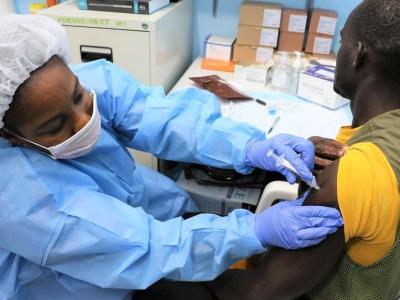Sep 4, 2007 (CIDRAP News) – Russian officials announced today that hundreds of chickens at a farm in southern Russia died of H5N1 avian influenza, as international experts met in Bangkok to discuss how to better monitor the spread of the disease in Asia.
The poultry deaths were discovered in the town of Razdolny in Krasnodar territory on Sep 2, RIA Novosti, Russia's state news agency, reported today. The disease struck about 500 chickens.
A spokesman for the territorial veterinary agency said a regional laboratory identified the H5N1 virus in the dead birds and that further tests were under way to confirm the results, the RIA Novosti report said. Authorities planned to cull 22,000 birds on the affected farm, the veterinary official said.
The new wave of poultry deaths occurred in the same territory as a January outbreak that marked a recurrence of the disease in Russia after a 5-month lull. In February, the virus struck backyard birds at several locations on the outskirts of Moscow. Reports filed with the World Organization for Animal Health (OIE) show no other Russian outbreaks since then.
Measures were being taken to contain the outbreak, the veterinary agency spokesman told RIA Novosti. Russia's veterinary watchdog agency, Rosselkhozadzor, said authorities have slaughtered 414 birds, according to an Associated Press report.
Meanwhile, animal-health experts from a dozen countries are meeting in Bangkok this week at a conference sponsored by the United Nations Food and Agriculture Organization (FAO) to hear reports from Asian countries on their H5N1 wildlife surveillance efforts and discuss how countries can better coordinate their activities, according to an FAO statement.
Yesterday, an FAO official cast doubt on any major role of wild birds in spreading the H5N1 virus, saying more efforts should be focused on controlling the disease in domestic birds, news services reported.
Scott Newman, international wildlife coordinator for the FAO, said the virus hasn't been found in any of 300,000 to 350,000 healthy wild birds that have been sampled in global surveillance activities in the past 2 years, the Australian Press (AP) reported.
"We know now that we haven't found a species that even suggests that it would be a reservoir for this disease," he said, according to the AP report.
Experts said some countries test healthy wild birds, while others test for H5N1 only in sick or dead birds, the AP reported. So far the virus has been found in 90 species of birds.
Scarce H5N1 findings in wild birds don't mean surveillance efforts should stop, Newman said. Instead, countries should fine-tune monitoring activities by, for example, improving testing at sites where domestic and wild birds mingle.
Officials attending the meeting, which includes 70 experts, said the only way to get an accurate view of H5N1 in wild birds is to establish a uniform and comprehensive surveillance system, according to a Voice of America (VOA) report dated yesterday.
Last year, FAO officials expressed concern that migratory birds would spread the H5N1 virus from Asia and Europe to Africa. However, William Karesh, program director of the Wildlife Conservation Society's field veterinary program, said surveillance has found very few instances of the virus in Africa's wild birds, according to the VOA report.
He said the illegal trade in wildlife in Africa and elsewhere makes tracking the virus particularly challenging, the VOA reported. The FAO meeting ends tomorrow.
See also:
OIE reports on Russian H5N1 outbreaks
http://www.oie.int/downld/AVIAN%20INFLUENZA/A2007_AI.php
FAO statement on Bangkok meeting
http://www.fao.org/avianflu/news/bangkok_wild.htm
Jun 2, 2006, CIDRAP News story "FAO: Wild birds play role in avian flu, but poultry key"


















